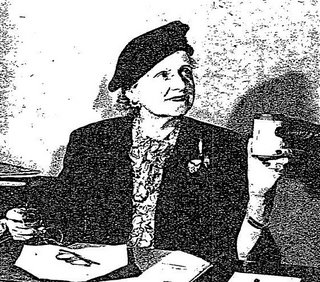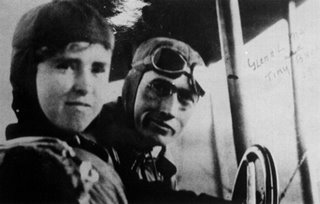 "An unfailing intellect, imperturable temper, great self-reliance and as great modesty, seeing the right clearly, pursuing it steadfastly, he lived and died."
"An unfailing intellect, imperturable temper, great self-reliance and as great modesty, seeing the right clearly, pursuing it steadfastly, he lived and died." -- Bishop Milton Wright, in a eulogy to his son, 1912.
History lumps Wilbur and Orville Wright together, but they were very different characters, both essential to the breakthrough at Kitty Hawk, North Carolina on December 17, 1903 that launched the phenomenon of aviation.
Born on this day in 1867 near Millville, Indiana, the elder of the two brothers, Wilbur was a handsome, serious, dedicated student who hoped to follow in his father's footsteps (who was a progressive bishop in the Church of the United Brethren in Christ) by going to Yale and becoming a minister. Just before he was to graduate from high school, however, Wilbur was playing street hockey and got hit in the mouth with a hockey stick, losing all of his front top teeth. Ashamed of the way he looked, he developed heart palpitations that overlayed his depression and self-doubt, and shortly thereafter he abandoned all hope of pursuing the life plan he had mapped for himself. Instead he consigned himself to the inside of the Wright home for three years, reading and caring for his mother who was dying of tuberculosis.
Avid young Orville pestered his brother out of his melancholy, inviting him to join Orville's fledgling printing and newspaper business and later, as a partner in the brothers' hand-crafted bicycle shop. His attention to engineering issues at the bicycle shop and the ongoing press accounts of the developmental failures of would-be aviators Otto Lilienthal and Samuel Langley (among others) encouraged Wilbur to begin to think about the possibilities of machine-powered flight.
He and Orville began to think of the aviation riddle as three separate problems: (1) building wings that would lift the weight of the pilot and the motor off of the ground (something Lilienthal had already done with his gliders), (2) having a power plant to propel the craft through the air, and (3) the most difficult problem, having a way to control the craft once it was airborne. Wilbur thought that being able to twist the wings, a mechanism later to be known as "wing warping," would give the pilot control over his craft, and began to experiment with a biplane box kite he and Orville built, with wings braced with wires which could be twisted to make the kite bank and turn. They reported their success with wing-warping to Octave Chanute, then considered the country's expert on aeronautics, who immediately recognized that they were ahead of most of the people who were working on flight.
In 1900 the brothers began to test their glider designs at Kitty Hawk, North Carolina, an isolated stretch of dunes on the Atlantic coast which offered them privacy and by reputation the steadiest winds in the U.S. The first year they learned that their initial wingspan did not create enough lift to raise a human being off the ground, but that the control mechanisms seemed to work when the craft was flown as a kite; the following year, amid torrential rains and mosquitoes, they learned that a larger wingspan permitted the glider to carry Wilbur on short hops, but that the controls, theoretically based on Lilienthal's calculations of lift tables, couldn't keep Wilbur from smacking into the ground and splitting open his forehead.
After developing a revised set of lift tables back in Dayton, they returned to Kitty Hawk in 1902 with a new glider design, and following intense discussion and debate, fitted the back of the glider with a hinged tail rudder which was linked to the wing-warping mechanism. The moment Wilbur launched from the top of West Hill, he knew that the control mechanism finally worked. In 1903, they reappeared in Kitty Hawk with a new glider, the
Flyer, fitted with an engine and propellers built by their bicycle shop mechanic Charley Taylor. Without press coverage or government observers, at 10:35 a.m. on December 17, Orville lifted off in the
Flyer for the first sustained powered and controlled flight in history, a mere 12-second voyage. Taking turns at the helm, the brothers made three more flights that day, Wilbur's being the longest at 59 seconds and 852 feet.
When they tried to inform the press, the U.S. government and the Europeans (who, within the next 5 years, were to make strides through the work of Alberto Santos-Dumont), all quarters refused to believe that the little bicycle shop mechanics had actually achieved flight. The Wrights secured their patents and went underground for awhile, hoping to find financial backing for their technology. After Santos-Dumont claimed the title of "father of aviation" with his wobbly 200-foot hop in 1906, Professor Chanute pleaded with the Wrights to put on a show.
Wilbur went to LeMans, France, and on August 8, 1908 effortlessly took off before a wide-eyed crowd, turning and banking with ease. The French conceded defeat, and Wilbur became the toast of Europe. After a successful test for the U.S. government, a crash and a recovery, Orville joined Wilbur on the grand tour of the continent, with "princes and millionaires . . . as thick as fleas," flying demonstrations before delighted onlookers. By the end of the tour, the world's first barnstorming pilot had grown tired of barnstorming, and Wilbur dragged Orville back to Dayton in 1909 to continue to work on airplane designs and defend their patents against infringements in a series of lawsuits.
Wilbur died of typhoid fever at the age of 45 on May 30, 1912, only catching a glimpse of what his work would do to transform the lives of human beings forever.
Labels: Air and Space

















